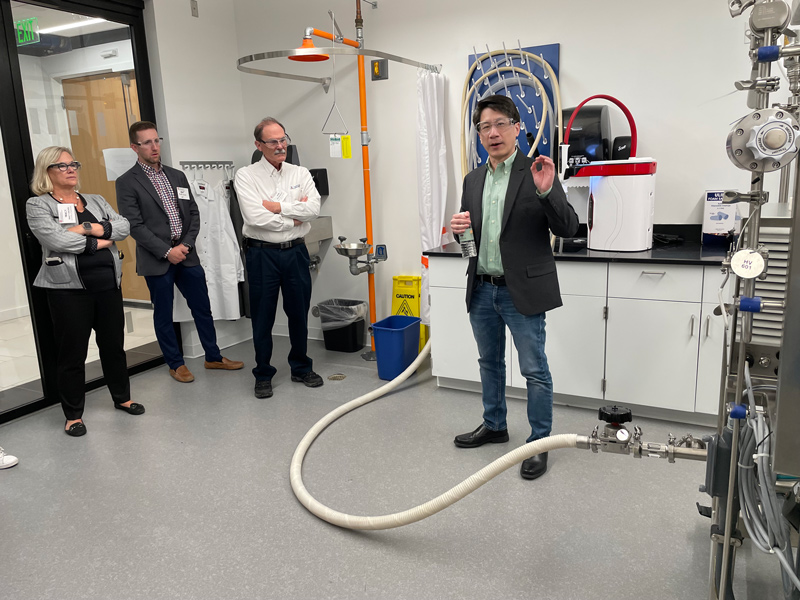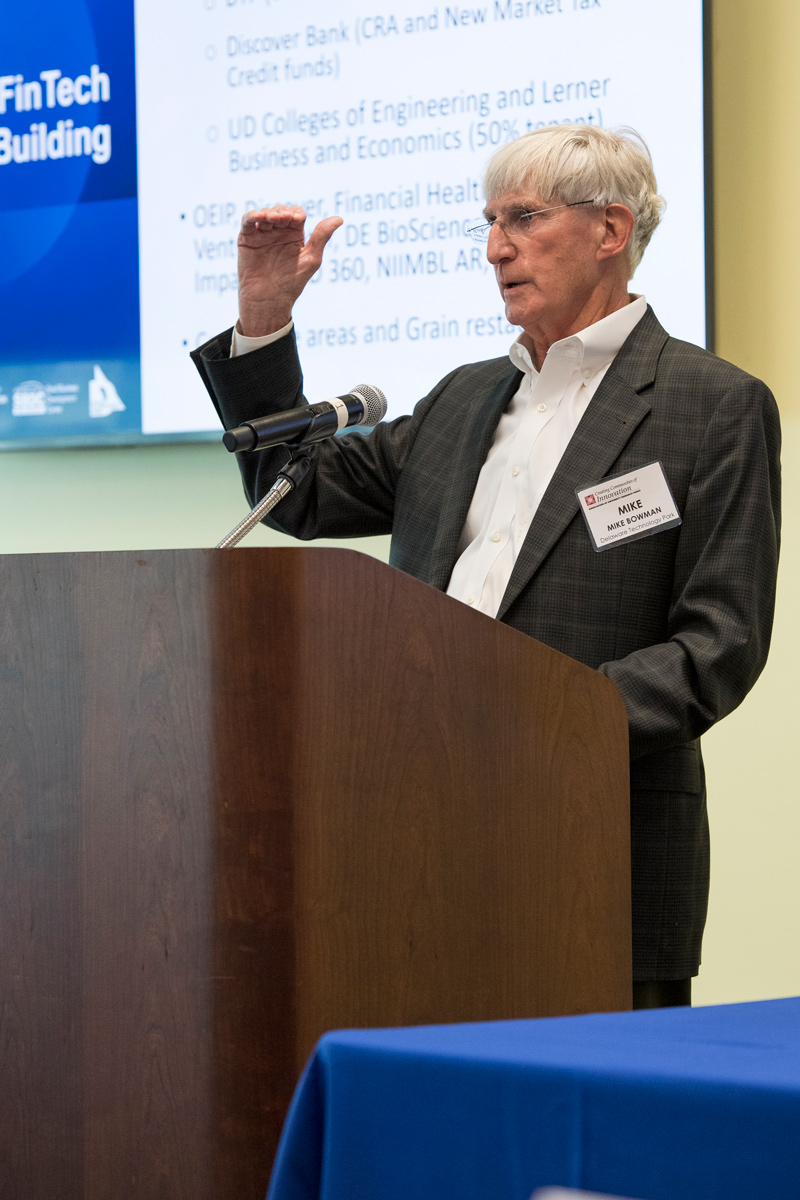


UD’s growing research hub shines
Photos by Kathy F. Atkinson and Beth Miller July 14, 2022
STAR Campus gets high marks from Association of University Research Parks
The temporary certificate of occupancy was barely in the hands of Mike Bowman, president of Delaware Technology Park (DTP), when the new FinTech Innovation Hub at the University of Delaware was pressed into service.
The six-story building on UD’s Science Technology and Advanced Research (STAR) Campus hosted a meeting of the Association of University Research Parks in mid-May, with members from across North America visiting to learn about development of the STAR Campus and how researchers are using their new space.
Work on the FinTech building, which is owned by DTP, continued as association members met.
It was an ideal symbol for the theme of the gathering: “The Evolution of P3 Innovation Models.” P3 is an abbreviation for Public-Private Partnership, which is in motion just about everywhere on UD’s STAR Campus and on two other partner-based research sites — DTP’s Research Park on East Campus and the Delaware Innovation Space in Wilmington, less than 20 miles north of UD’s Newark campus.
“In Delaware, because we’re a small state and very connected, we’re very good at partnering,” said Tracy Shickel, director of economic development for UD, as she greeted guests.
The 272-acre STAR Campus, which once was the location of a sprawling Chrysler assembly plant, now is home to about 1 million square feet of real estate, including multiple buildings, wet labs and more than 30 enterprises touching research, healthcare, financial technology, education, economic development, incubation, community engagement and manufacturing. About $500 million has been invested in the site in just over 10 years.
It is meant to be a hub of innovation and connection, an intersection for those pursuing world-class research, high-level academic endeavors, entrepreneurship and community impact. And those things are happening in ever-increasing measure. Students find research opportunities and internships with established and emerging companies. Faculty find new and expanded research opportunities. Businesses find new ideas, new collaborators and new opportunities for growth.

DTP has been building such connections for years, aiming to promote economic growth and create high-value jobs in the Mid-Atlantic region. The FinTech Innovation Hub, when fully built out, will have financial institutions, small businesses, nonprofits, technology companies and the Delaware Small Business Development Center, Bowman said.
Visitors toured parts of that new Fintech building, where specialists in finance will be able to connect with engineers, computer scientists and business leaders.
They also visited parts of the nearby Ammon Pinizzotto Biopharmaceutical Innovation Center, including the Delaware Bioimaging Center and the National Institute for Innovation in Manufacturing Biopharmaceuticals (NIIMBL).
“Delaware would be nothing without the Public-Private Partnership,” Bowman said. “When you’re little, you have to punch above your weight.”
The STAR Campus is symbolic of all of that. UD purchased the site for $25 million and owns one research building — the 226,000-square foot Ammon Pinozzotto center. The rest of the site is based on a ground lease model and is situated in a federally designated Opportunity Zone, which offers certain tax advantages to investors.
The campus sits adjacent to the newly renovated Newark Regional Transportation Center train station, which enables easy connection to New York City, Washington D.C. and anywhere Amtrak rolls, as well as the extended regional reach of SEPTA commuter trains. A new restaurant — the alumni-owned Grain Craft Bar + Kitchen — is expected to open soon on the first floor of the FinTech building and there are ongoing discussions for future residential and hotel amenities.
Kurt Foreman, president and CEO of the non-profit economic development agency Delaware Prosperity Partnership, said public-private partnerships are a hallmark of innovation in Delaware and key to DPP’s mission to attract and retain businesses.
“This [Delaware] is a place where innovation has happened for hundreds of years, whether you go back to 1802 — when the DuPont Co. was created with all of the spinoffs that came later — or to the University or elsewhere, where a great idea comes into someone’s mind,” Foreman said. “We have a team that brings an ecosystem together to be sure we can be as supportive and as rich a soil for innovation as possible.”
With an annual budget of about $3.5 million, DPP focuses on five sectors, including:
Business and finance
Manufacturing and logistics
Healthcare and education
Agriculture and food
Science and technology
The five-year-old DPP has completed 46 projects throughout the state so far, with more than $1.4 billion in capital investment, Foreman said.
Charles G. Riordan, former vice president for research, scholarship and innovation for the University of Delaware, talked about several other important UD research partnerships.
For example, a new tenant in the Ammon Pinizzotto building is Immerse Delaware, which in May opened its research and innovation lab. Immerse Delaware is a five-year partnership between UD and the Waters Corporation, a Massachusetts-based pioneer in scientific measurement.
That research will include analytical work in biopharmaceutical manufacturing, sensor development, data science and data analytics, Riordan said. And it will benefit from proximity to NIIMBL, which is also an Ammon Pinizzotto building tenant.
NIIMBL is one of 16 Manufacturing USA Institutes. Its mission is to expedite and improve manufacture of large-molecule medicines, including insulin, monoclonal antibodies, cancer medicines, vaccines, cell therapies and gene therapies. The NIIMBL partnership now has about 200 members, including universities, non-profits, businesses and community colleges. Seven federal agencies are engaged.
UD also was a founding partner of the Delaware Innovation Space, which now occupies 130,000 square feet at DuPont’s Experimental Station in Wilmington. It serves as a business incubator, with space for science-based startup companies and entrepreneurs.
“These are tremendous opportunities for our faculty and our students to get involved in real-world problems,” said Riordan, who in July began a new role as provost and senior vice president for academic affairs at Hofstra University.
Though Delaware does not have a medical school within state boundaries, the state has a strong partnership with Thomas Jefferson Medical School in Philadelphia. UD also has strong programs with ChristianaCare Health Systems, Nemours Children’s Hospital, Beebe Healthcare, the Wilmington VA Medical Center and Delaware INBRE (IDeA Network of Biomedical Research Excellence).
“We’ve found the sweet spot for our ecosystem to work very collaboratively,” Riordan said. “It works very well here.”
Participants also heard from:
Michael Casson, dean of Delaware State University’s College of Business
Michael Fleming, president of the Delaware Bioscience Association
Matthew Parks, vice president, Community Reinvestment Act officer and retail banking for Discover Bank, the sponsor of the new FinTech Innovation Hub
Michelle Mooney, director of the National Development Council
Kelvin Lee, interim vice president for research, scholarship and innovation, founding director of NIIMBL, and Gore Professor of Chemical and Biomolecular Engineering at UD
Brian Darmody, chief strategy officer, Association of University Parks
Conference participants toured part of the NIIMBL site with Lee and had a look at the Delaware Bio-Imaging Center, directed by Jeff Caplan, which offers state-of-the-art microscopy, including confocal microscopes, super-resolution microscopes, electron microscopes and atomic-force microscopes. The center draws about 200 users each year, Caplan said.
Leah Burton, director of the Centennial Campus Partnership Office and Industry Alliances at North Carolina State and president of the board of AURP, was impressed with what she saw.
“One of the things that lingers with me is the fact that University of Delaware has now done this three times,” she said. “This is the third research park or innovation space it has created. It gives such flexibility to the University and the researchers and corporate partners they work with. At a time when many universities are trying to do this once — they’ve done it now three times. I’m really impressed. They’ve been so creative.”
Austin Beggs of Saskatoon, Saskatchewan in Canada, strategic advisor to the market research and strategic planning firm called Stiletto: Make a Point, was glad he attended.
“The tour of the lab building was interesting and inspiring. You rarely get to see platform technology development happening in front of your eyes,” said Beggs. “The presentation about NIIMBL was an example of how the United States is rearranging its scientific attitudes in order to better position themselves for the future. It’s very impressive.”
Contact Us
Have a UDaily story idea?
Contact us at ocm@udel.edu
Members of the press
Contact us at 302-831-NEWS or visit the Media Relations website

